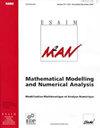A Krylov subspace type method for Electrical Impedance Tomography
IF 1.9
3区 数学
Q2 Mathematics
Esaim-Mathematical Modelling and Numerical Analysis-Modelisation Mathematique et Analyse Numerique
Pub Date : 2021-09-26
DOI:10.1051/m2an/2021057
引用次数: 1
Abstract
Electrical Impedance Tomography (EIT) is a well-known imaging technique for detecting the electrical properties of an object in order to detect anomalies, such as conductive or resistive targets. More specifically, EIT has many applications in medical imaging for the detection and location of bodily tumors since it is an affordable and non-invasive method, which aims to recover the internal conductivity of a body using voltage measurements resulting from applying low frequency current at electrodes placed at its surface. Mathematically, the reconstruction of the internal conductivity is a severely ill-posed inverse problem and yields a poor quality image reconstruction. To remedy this difficulty, at least in part, we regularize and solve the nonlinear minimization problem by the aid of a Krylov subspace-type method for the linear sub problem during each iteration. In EIT, a tumor or general anomaly can be modeled as a piecewise constant perturbation of a smooth background, hence, we solve the regularized problem on a subspace of relatively small dimension by the Flexible Golub-Kahan process that provides solutions that have sparse representation. For comparison, we use a well-known modified Gauss-Newton algorithm as a benchmark. Using simulations, we demonstrate the effectiveness of the proposed method. The obtained reconstructions indicate that the Krylov subspace method is better adapted to solve the ill-posed EIT problem and results in higher resolution images and faster convergence compared to reconstructions using the modified Gauss-Newton algorithm.电阻抗层析成像的Krylov子空间型方法
电阻抗断层扫描(EIT)是一种众所周知的成像技术,用于检测物体的电气特性,以检测异常,如导电或电阻性目标。更具体地说,EIT在医学成像中有许多应用,用于检测和定位身体肿瘤,因为它是一种负担得起的非侵入性方法,旨在通过在放置在其表面的电极上施加低频电流产生的电压测量来恢复身体的内部电导率。在数学上,内部电导率的重建是一个严重的不适定逆问题,产生的图像重建质量很差。为了弥补这一困难,至少部分地,我们在每次迭代中借助于线性子问题的Krylov子空间型方法来正则化和解决非线性最小化问题。在EIT中,肿瘤或一般异常可以被建模为光滑背景的分段常数扰动,因此,我们通过灵活的Golub-Kahan过程在相对小维的子空间上解决正则化问题,该过程提供了具有稀疏表示的解。为了比较,我们使用了一个著名的改进高斯-牛顿算法作为基准。通过仿真验证了该方法的有效性。实验结果表明,Krylov子空间方法比改进的高斯-牛顿算法更适合于求解不适定EIT问题,具有更高的图像分辨率和更快的收敛速度。
本文章由计算机程序翻译,如有差异,请以英文原文为准。
求助全文
约1分钟内获得全文
求助全文
来源期刊

CiteScore
2.70
自引率
5.30%
发文量
27
审稿时长
6-12 weeks
期刊介绍:
M2AN publishes original research papers of high scientific quality in two areas: Mathematical Modelling, and Numerical Analysis. Mathematical Modelling comprises the development and study of a mathematical formulation of a problem. Numerical Analysis comprises the formulation and study of a numerical approximation or solution approach to a mathematically formulated problem.
Papers should be of interest to researchers and practitioners that value both rigorous theoretical analysis and solid evidence of computational relevance.
 求助内容:
求助内容: 应助结果提醒方式:
应助结果提醒方式:


